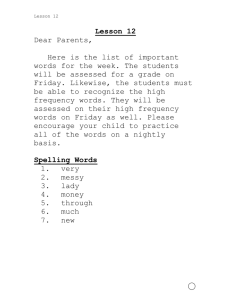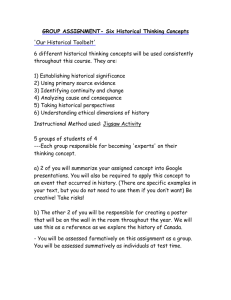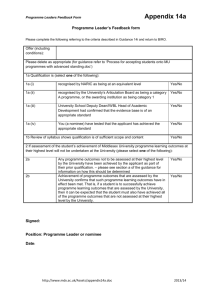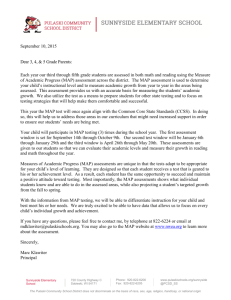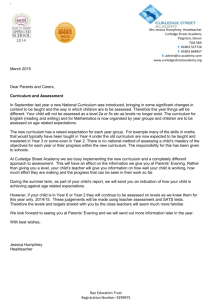Key Concepts - Louisiana Department of Education
advertisement
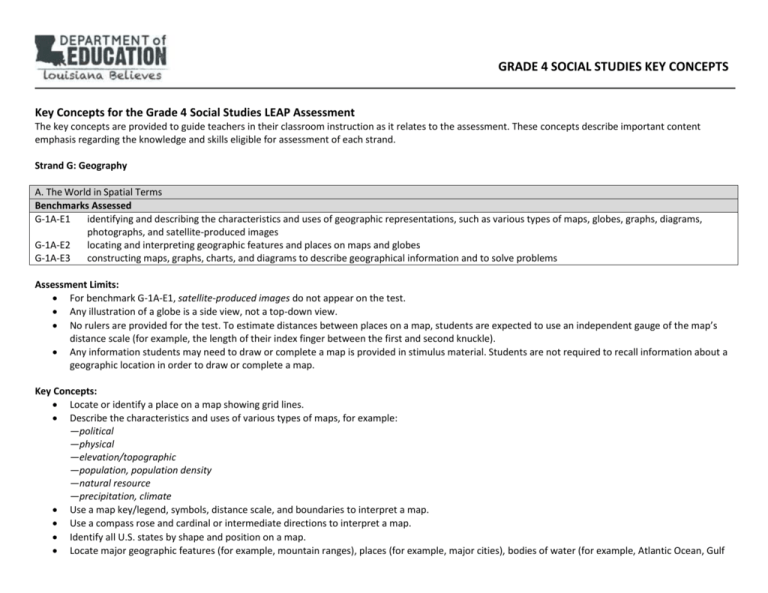
GRADE 4 SOCIAL STUDIES KEY CONCEPTS Key Concepts for the Grade 4 Social Studies LEAP Assessment The key concepts are provided to guide teachers in their classroom instruction as it relates to the assessment. These concepts describe important content emphasis regarding the knowledge and skills eligible for assessment of each strand. Strand G: Geography A. The World in Spatial Terms Benchmarks Assessed G-1A-E1 identifying and describing the characteristics and uses of geographic representations, such as various types of maps, globes, graphs, diagrams, photographs, and satellite-produced images G-1A-E2 locating and interpreting geographic features and places on maps and globes G-1A-E3 constructing maps, graphs, charts, and diagrams to describe geographical information and to solve problems Assessment Limits: For benchmark G-1A-E1, satellite-produced images do not appear on the test. Any illustration of a globe is a side view, not a top-down view. No rulers are provided for the test. To estimate distances between places on a map, students are expected to use an independent gauge of the map’s distance scale (for example, the length of their index finger between the first and second knuckle). Any information students may need to draw or complete a map is provided in stimulus material. Students are not required to recall information about a geographic location in order to draw or complete a map. Key Concepts: Locate or identify a place on a map showing grid lines. Describe the characteristics and uses of various types of maps, for example: —political —physical —elevation/topographic —population, population density —natural resource —precipitation, climate Use a map key/legend, symbols, distance scale, and boundaries to interpret a map. Use a compass rose and cardinal or intermediate directions to interpret a map. Identify all U.S. states by shape and position on a map. Locate major geographic features (for example, mountain ranges), places (for example, major cities), bodies of water (for example, Atlantic Ocean, Gulf GRADE 4 SOCIAL STUDIES KEY CONCEPTS of Mexico, Great Lakes), or waterways (for example, Mississippi River) on a map of Louisiana or of the United States. Locate places on a map or representation of a globe, for example: —hemispheres —continents —the United States —major landforms (for example, Rocky Mountains, Appalachian Mountains, Grand Canyon) —major bodies of water or waterways (for example, the four oceans, Gulf of Mexico, Mississippi River, Great Lakes) —Equator, North Pole, South Pole Draw, complete, or add features to a map (including such map elements as a title, compass rose, legend, or scale), based on information given in narrative form. Show the location of a specified place by entering it on a labeled grid (for example, “the library is located at [grid point] E-3”). Construct a chart or diagram to display geographical information in an organized way. Construct a bar graph, line graph, circle/pie graph, or pictograph to represent given geographical data. B. Places and Regions Benchmarks Assessed G-1B-E1 describing and comparing the physical characteristics of places, including landforms, bodies of water, soils, vegetation, and climate G-1B-E2 identifying and describing the human characteristics of places, including population distributions and culture G-1B-E3 describing how the physical and human characteristics of places change over time G-1B-E4 defining and differentiating regions by using physical characteristics, such as climate and landforms, and by using human characteristics, such as economic activity and language Assessment Limits: G-1B-E1 and G-1B-E2 are particularly well suited for constructed-response or task items. Students are not required to recall the specific terrain, climate, or vegetation of any region outside the United States. Test items for G-1B-E1 do not test types of soil. Test items for G-1B-E2 are limited to population density and human characteristics noted under the Key Concepts below. Other aspects of culture are reserved for testing under category C, benchmark G-1C-E4. Test items for G-1B-E3 do not address population migration (see G-1C-E3) or physical processes that shape Earth’s surface (see G-1C-E1). Regarding economic activity, G-1B-E4 focuses on distinguishing among regions, not on analyzing given distributions of economic activities (see G-1C-E5). GRADE 4 SOCIAL STUDIES KEY CONCEPTS Key Concepts: Identify examples or compare the distinguishing characteristics of various landforms, for example: —continents —islands —plateaus, plains, hills, and mountains —deserts —swamps, marshes, and wetlands Identify or compare the distinguishing characteristics of various bodies of water (for example, lakes, oceans, seas, gulfs) and waterways/rivers. Identify or compare the distinguishing characteristics of various climates (for example, tropical, temperate, cold, arid), and various forms of vegetation (for example, cactus, cypress trees, grasslands). Describe or compare mountainous areas, hilly areas, plains, swamps, and deserts. Compare northern vs. southern regions in terms of vegetation and climate. Identify the best place for human settlement based on a map showing physical characteristics of an area. Identify or describe the distribution of population in a region or larger area based on given information (population density). Identify, describe, or compare human characteristics of a particular place, based on given information. Describe how certain physical and human characteristics (for example, clothing, jobs, shelter, methods of transportation, and tools) have changed since colonial times. Explain physical and human developments in a region since it was first settled, based on given information. Recognize English as the major language of the United States and identify French and Spanish as secondary languages in certain regions of the country. Identify, describe, or compare the population density or the physical, economic, and other human characteristics of the local region and U.S. regions, for example: —Northeast —Southeast —Midwest —Northwest/Rocky Mountain states —Southwest —Pacific/West Coast GRADE 4 SOCIAL STUDIES KEY CONCEPTS C. Physical and Human Systems Benchmarks Assessed G-1C-E1 describing how physical processes help to shape features and patterns on Earth’s surface G-1C-E2 describing and comparing the types of settlement and patterns of land use in local communities, the United States, and world regions G-1C-E3 describing and explaining the characteristics, distribution, and migration of human population G-1C-E4 identifying and comparing the cultural characteristics of different regions and people G-1C-E5 locating and explaining the spatial distribution of economic activities G-1C-E6 identifying and describing types of territorial units, such as parishes or counties, states, and countries Assessment Limits: Under G-1C-E1, physical processes exclude natural disasters, which are assessed under G-1D-E3. For G-1C-E3, test items are restricted to analysis of population characteristics or general principles underlying human migration. Aspects of population distribution are assessed under benchmark G-1B-E3. Test items requiring knowledge of specific historical migrations are assessed under History benchmark H-1C-E3. Key Concepts: Regions of the U.S. (see Key Concepts in Geography category B). Identify physical processes that change Earth’s surface suddenly or over time, for example: —ice age, glaciers —water currents —volcanic eruptions —earthquakes Describe the physical processes that created the Grand Canyon, Great Lakes, and Hawaiian Islands. Identify the effects on Earth’s surface of a particular physical process (for example, erosion, faults, new islands from volcanic eruptions). Identify how land use affected human migration and settlement patterns, for example: —urban vs. rural settlements —migration to urban and suburban centers —westward expansion Identify or compare features of urban, suburban, and rural communities. Compare city life to rural life. Identify geographical/physical reasons for regional variations in land use, for example: —farming —mining —drilling for oil and gas GRADE 4 SOCIAL STUDIES KEY CONCEPTS —fishing Identify reasons why people move from place to place, for example: —find work —seek new opportunities —better their lives —escape religious persecution —escape political oppression —flee severe geographical conditions, such as drought or famine Identify or analyze characteristics of the human population in a given area, for example: —cultural diversity —population size —population growth Identify, describe, or compare the cultural identities of various U.S. regions (for example, how clothing of people in the Southwest differs from clothing in the Northeast). Describe or compare cultural characteristics (for example, shelter, food, dress, celebrations, language, or music) of any region, based on given information. Explain how a region is influenced by past events and the heritage of its people. Identify the economic activities of Louisiana or the local region (that is, how people earn their living). Identify the relationship between geography and economic activities in Louisiana. Identify the importance of specific industries to various regions in Louisiana and the United States. Differentiate between territorial units: —towns/cities —parishes/counties —states —nations/countries D. Environment and Society Benchmarks Assessed G-1D-E1 identifying and explaining ways in which people depend upon and modify the physical environment G-1D-E2 describing how humans adapt to variations in the physical environment G-1D-E3 describing the locations, causes, and effects of natural disasters on the environment and society G-1D-E4 describing the use, distribution, and importance of natural resources GRADE 4 SOCIAL STUDIES KEY CONCEPTS Assessment Limits: G-1D-E1 and G-1D-E2 are particularly well suited to constructed-response or task items. Under G-1D-E3, causes and effects of natural disasters are not tested. Items may require students to know areas of the U.S. prone to certain natural disasters. (Items on earthquakes and volcanoes do not duplicate ideas assessed in G-1C-E1.) Under G-1D-E4, distribution of natural resources is not tested, except as represented on a map. Items stress the use and importance of natural resources. Key Concepts: Explain ways in which people depend on the physical environment to satisfy basic needs. Identify or explain ways in which humans modify the physical environment to meet basic needs or achieve certain purposes, for example: —clearing land for urban development —building roads to improve access to an area —irrigating land, draining swamps —clearing land/cutting down forests —building roads, canals, tunnels, levees, or flood walls —building up coastal areas —mining natural resources Identify or explain positive and negative consequences of human modifications to Earth’s surface and the physical environment. Identify natural disasters and recognize those common in the local region, for example: —floods —hurricanes —earthquakes —forest fires —volcanoes —tornadoes Identify areas prone to certain natural disasters, for example: —hurricanes in the Gulf of Mexico —tornadoes in the Midwest —earthquakes in California —volcanoes in Hawaii/the Pacific Northwest (for example, Mount St. Helens) Identify examples of natural resources and their uses, for example: —trees/forests (lumber, paper) —fresh water (drinking) —seawater (salt) GRADE 4 SOCIAL STUDIES KEY CONCEPTS —coal, natural gas, oil (electricity, heat) —minerals in Earth (aluminum) —plants, roots, herbs (medicines, dyes) Describe natural resources found in the local region (for example, sugar cane, trees, oil, cotton, rice, soybeans). Describe the importance of specific natural resources to human survival and human endeavors. Interpret a map to describe the distribution of natural resources in a given area. Strand C: Civics A. Structure and Purposes of Government Benchmarks Assessed C-1A-E2 explaining the necessity and basic purposes of government C-1A-E3 comparing limited governments to unlimited governments C-1A-E4 identifying and describing some of the major responsibilities of local, state, and national governments C-1A-E5 identifying key members of government at the local, state, and national levels and describing their powers and the limits on their powers C-1A-E6 explaining how officials in government acquire the authority to exercise political power C-1A-E7 explaining the purposes and importance of rules and laws Assessment Limits: Benchmark C-1A-E1 (describing government in terms of the people and groups who make, apply, and enforce rules and laws in the home, school, community, and nation) is not assessed on LEAP. Test items on powers and limits of government officials are restricted to the list of key officials in the Key Concepts below. Key Concepts: Identify the necessity or basic purposes of government in such terms as establishing order, providing security, managing conflict, and providing services. Identify ways that government helps meet the basic needs of society, for example: —providing education —supplying social welfare —building and maintaining roads —providing and maintaining public facilities (post office, hospitals, schools, libraries) Distinguish between limited government wherein powers of leading government officials are limited (for example, by a constitution) and unlimited government wherein there is little or no control over the ruler’s power (for example, as in a dictatorship). Identify major responsibilities of local, state, and national government (for example, national defense, levying taxes, building roads or state highways). Identify the three branches of the federal government—legislative, executive, judiciary—and describe their primary functions. GRADE 4 SOCIAL STUDIES KEY CONCEPTS Identify key government positions at the local, state, and national levels, their respective powers, and limits on their powers. Identify the term of office for president and vice president of the United States. Identify the term of office for the governor of Louisiana. Compare or contrast the roles of key government officials. Explain how government officials at the local, state, and national levels are elected. Distinguish between election and appointment. Define rules and laws. Explain the need/purpose/importance of having rules in the school, community, and society at large (for example, to provide order and safety). Explain the importance of obeying rules or laws and the consequences of violating them. Propose rules for a given situation and explain why the rules would be important. B. Foundations of the American Political System Benchmark Assessed C-1B-E1 identifying basic principles of American constitutional democracy and explaining how the constitutions of the United States and Louisiana reflect these principles Assessment Limits: Benchmark C-1B-E2 (discussing the importance of citizens’ sharing and supporting the principles of American constitutional democracy) is not directly assessed. Themes relevant to this benchmark may be assessed under Civics category D. Key Concepts: Define democracy. Explain basic freedoms (for example, freedom of speech, religion, press, assembly, and petition). Identify or discuss specific basic freedoms guaranteed by the Bill of Rights. Identify the U.S. Constitution as the supreme law of the land. Identify or discuss specific principles of the U.S. Constitution. Explain how laws and rules are based on the U.S. Constitution. Describe how the Constitution reflects basic principles of American democracy. Recognize that Louisiana has a constitution patterned after the U.S. Constitution. GRADE 4 SOCIAL STUDIES KEY CONCEPTS C. International Relationships Benchmark Assessed C-1C-E1 explaining that the world is divided into different nations and describing the major ways that these nations interact Assessment Limits: Test items may require students to understand that each nation has its own land, people, government, and laws. However, except for democracy, various forms of government are not assessed in this or any other category at grade 4. Test items should emphasize trade and diplomacy as modes of international interaction, but may also refer to methods of resolving problems (for example, treaties). Key Concepts: Explain the concept of a nation with reference to countries, governments, and people. Identify major ways that nations interact (for example, trade, diplomacy). Identify the function of treaties between nations. Define diplomacy in terms of representatives of countries meeting to try to resolve differences or solve problems peacefully. Identify the role of the United Nations (UN) in international peacekeeping. D. Roles of the Citizen Benchmarks Assessed C-1D-E1 explaining the meaning of citizenship and the means by which individuals become citizens of the United States C-1D-E2 describing the rights and responsibilities of citizenship in a democratic society C-1D-E3 identifying and discussing civic traits that are important to the preservation and improvement of American constitutional democracy C-1D-E4 describing the many ways that citizens can participate in and contribute to their communities and to American society C-1D-E5 discussing issues related to citizenship and public service Assessment Limits: Multiple-choice test items reflect matters of fact or core democratic principles. Care is exercised to avoid subjective bias in response choices. For C-1D-E1, test items do not use the term naturalization. For C-1D-E2, test items focus on rights and responsibilities of citizenship in any democratic society. The Bill of Rights may be cited, but only in terms of its function as a source of our basic rights. This restriction avoids content overlap with C-1B-E1 (see Civics category B). Assessment items may incorporate themes from C-1B-E2 (importance of citizens’ sharing and supporting the principles of American constitutional democracy). Benchmarks C-1D-E1 and C-1D-E2 are assessed only with multiple-choice items. GRADE 4 SOCIAL STUDIES KEY CONCEPTS Benchmarks C-1D-E3, C-1D-E4, and C-1D-E5 are assessed only with constructed-response or task items. Constructed-response items may include stimulus material, such as a picture, illustration, or an excerpt from a political speech/address or essay. Key Concepts: Define citizen and citizenship. Identify the means by which individuals become U.S. citizens (for example, by birth, by being born of American parents abroad, by process of naturalization). Identify the rights and responsibilities of citizenship in a democratic society (for example, the right to hold public office; the responsibility to vote in elections, pay taxes, or serve on a jury). Describe qualities of good citizenship and civic traits important to the preservation and improvement of American constitutional democracy, for example: —participating in public/community service —respecting others’ basic rights —working cooperatively with elected leaders —participating in the democratic process Describe ways in which individuals can participate in and contribute to their communities and American society, or exemplify qualities of good citizenship, for example: —being an informed citizen —participating in community service —displaying expressions of patriotism —serving in the military Describe actions individuals or groups may take to improve their community. Discuss ideas related to citizenship and public service (for example, the importance of leadership and participation, human rights issues, helping the less fortunate, or practicing compassion towards others). Discuss an excerpt from a speech, address, or essay related to the benchmarks in category D. GRADE 4 SOCIAL STUDIES KEY CONCEPTS Strand E: Economics A. Fundamental Economic Concepts Benchmarks Assessed E-1A-E1 recognizing that limited resources require people to make decisions E-1A-E2 identifying what is gained and lost when individuals or groups make decisions E-1A-E3 demonstrating how economic wants affect decisions about using goods and services E-1A-E4 discussing and determining the process for making economic decisions E-1A-E5 explaining the relationships among producers and consumers E-1A-E6 describing how natural resources, human resources, and capital (human-made) resources have been used and are combined in the production of goods and services E-1A-E7 describing how specialization affects productivity and contributes to the need for interdependence among producers and consumers E-1A-E8 determining how the development of skills and knowledge relates to career opportunity and economic well-being E-1A-E9 identifying different methods for the distribution of goods and services, including the concept of markets E-1A-E10 identifying some of the economic institutions, such as households and banks, that make up the economy E-1A-E11 explaining and demonstrating why people participate in voluntary exchanges and how money helps in the process Assessment Limits: Students should be able to apply, but are not required to know the following terms and concepts: productive resources, division of labor, specialization, productivity, economic wants, opportunity cost, or economic institution. Benchmarks E-1A-E5, E-1A-E6, E-1A-E7, E-1A-E10, and E-1A-E11 are assessed only by multiple-choice items. Key Concepts: Identify examples of scarcity (limited resources) at the individual or societal level. Demonstrate that limited resources require choices and decisions. Explain what is gained and what is lost in a given choice made by an individual or group. Identify examples of goods and services and explain the differences between goods and services. Explain how economic wants, or desires that can be satisfied by consuming a good or service, affect individual or group decisions about allocating limited resources. Explain or analyze trade-offs, or getting a little more of something in exchange for a little less of something else. Identify what is gained and what is given up in choosing one of several alternatives (for example, skating with friends vs. bowling with parents). Weigh the factors involved in a choice or decision (for example, discuss the choices and decisions involved in developing a personal budget). Identify examples of resources used to produce things, including natural resources (for example, coal), human resources (for example, workers), and capital resources (for example, machines). GRADE 4 SOCIAL STUDIES KEY CONCEPTS Identify various ways in which resources are used (for example, use of trees to produce wood for building, wood products, and heat). Describe the particular combination of natural, human, and capital resources needed to produce a given good or given service. Describe the roles of producers and consumers. Recognize that a person may be a producer or consumer in different contexts. Explain or analyze the interdependence of producers and consumers. Identify the effects of division of labor and specialization in a given context, such as a simple assembly line (for example, greater labor productivity/output per hour, interdependence of producers and consumers, and the need for teamwork). Describe the benefits of increasing one’s skills/knowledge and the various ways to do so. Explain that banks, governments, businesses, and households make up the economy as economic institutions. Explain why people engage in voluntary exchange/barter/direct trading (for example, because each expects to be better off after the exchange). Explain the advantages of using money over bartering (for example, eliminates the need to find a person with matching wants; money is a good that can be used to buy all goods). Describe the basic concept of a market (for example, exchange of goods and services between buyers and sellers). Identify ways of transporting goods (for example, trucking, shipping, pipeline). B. Individuals, Households, Businesses, and Governments Benchmarks Assessed E-1B-E1 describing how prices are determined by the interactions of buyers and sellers E-1B-E2 explaining how the changes in prices affect incentives to produce, consume, and save E-1B-E3 identifying and explaining economic concepts, such as profit, as an incentive for people to take economic risk E-1B-E4 explaining why some goods and services are provided by the government through taxing, charging user fees, and borrowing E-1B-E5 identifying the major goods and services produced in the local community and state Assessment Limits: For E-1B-E2, test items are restricted to incentives to produce and consume; incentives to save are not assessed. For E-1B-E4, test items focus on the government’s provision of paying for goods and services with taxation vs. user fees. Items do not require students to explore the concept of government borrowing. For E-1B-E5, test items address only goods and services for which Louisiana is a major producer. Goods and services of specific local communities are not assessed. Students should be able to apply, but are not required to recognize or use, the following terms: economic risk, incentive, or the common good. E-1B-E3 may be assessed with either multiple-choice or constructed-response items; other benchmarks in this category are assessed only as multiplechoice items. GRADE 4 SOCIAL STUDIES KEY CONCEPTS Key Concepts: Describe the elementary principles of supply and demand. Analyze a diagram or situation demonstrating the principles of supply and demand. Explain that producers produce more of the things many consumers need or want to buy and less of things fewer people need or want. Indicate what will most likely happen if the price of a product goes up (for example, quantity demanded will decrease). Describe how competition can affect the price of goods. Explain how a rise or a fall in prices affects personal, family, or government budgets. Explain why a decrease in price is an incentive for people to buy more, and for producers to produce less. Explain why an increase in price gives people an incentive to buy less, and for producers to produce more. Use the term risk in describing the chance of losing or gaining from an investment. Analyze a given scenario to explain the concept of profit (or reward) as an incentive for people to invest and risk money or labor. Identify government services provided for purposes of the common good (for example, national defense, public radio or television, public water and sewers). Explain why some services are provided by the government through taxation (for example, schools, fire and police departments, public streets). Explain why other government services are provided through charging user fees (for example, road tolls, entrance fees to national parks or museums). Identify major goods (for example, cotton, soybeans, rice, sweet potatoes, sugar cane, crawfish, timber, paper, natural gas, and oil) and services (for example, tourism) produced in Louisiana. Strand H: History A. Historical Thinking Skills Benchmarks Assessed H-1A-E1 demonstrating an understanding of the concepts of time and chronology H-1A-E2 recognizing that people in different times and places view the world differently H-1A-E3 identifying and using primary and secondary historical sources to learn about the past Assessment Limits: All benchmarks in category A may be assessed. Generally, however, they are not directly assessed with multiple-choice items. Although the skills in category A may be needed to answer a multiple-choice item, the item usually is keyed to a benchmark in one of the other History categories. H-1A-E1 and H-1A-E2 may be the principal focus of a constructed-response or task item and may be keyed as such. These items are accompanied by stimulus material. If a constructed-response or task item applies concepts of time and chronology to a strand other than History (for example, to Geography in regard to changes in Earth’s surface over time), the item is keyed to a benchmark in the relevant strand rather than to H-1A-E1. GRADE 4 SOCIAL STUDIES KEY CONCEPTS If a test item includes primary or secondary source material in order to assess a benchmark in a different category, the question is keyed to the respective benchmark rather than to H-1A-E3 (for example, to a Civics benchmark measured by an excerpt from the Declaration of Independence). Key Concepts: Develop or complete a timeline based on information given in a passage. Interpret data presented in a timeline. Discuss historical events in chronological order based on information in a timeline or given text. Describe the past in contrast to the present. Explain change or continuity over time (for example, explain how a society has changed over a given period of time based on information in stimulus material). Describe the point of view of a person or group in a historical context, drawing on given stimulus material. Describe the point of view of a historical figure or group, drawing on given stimulus material (for example, views expressed in Martin Luther King Jr.’s “I Have a Dream” speech; early American settlers’ view of their new world). Contrast the viewpoints of two figures living in different historical time periods. Contrast the viewpoints of people living in an earlier time to the perspective of people today. Use information in a map, table, or graph to describe historical factors or trends. Interpret historical information in a map, table, or graph (including applying necessary mathematical skills): —primary and secondary source material —documents core to U.S. democracy —journal, diary, or autobiography —encyclopedia —almanac —newspaper or magazine article —charts and graphs —famous speeches and addresses —biography —other reference books —historical fiction —pictures and illustrations GRADE 4 SOCIAL STUDIES KEY CONCEPTS B. Families and Communities Benchmarks Assessed H-1B-E1 describing and comparing family life in the present and the past H-1B-E2 relating the history of the local community and comparing it to other communities of long ago Assessment Limits: For H-1B-E2, test items treat the concept local community in broadest terms because individual Louisiana communities differ too much to require all students to make specific comparisons with communities of long ago. The only exception would be items with stimulus material that provides all necessary information about a local community. Key Concepts: Describe family life at a given time in history (for example, early America). Compare present-day family life with family life in a past time (for example, homes, jobs, schooling, dress, customs, housekeeping, recreation, transportation, or communication). Describe changes in community life, comparing a given time in history to the present in rural, urban, and suburban areas. Describe changes in a community’s appearance over time, based on a visual stimulus. Explain how technology has changed present-day family or community life compared to earlier times. C. Louisiana and United States History Benchmarks Assessed H-1C-E1 describing the people, events, and ideas that were significant to the growth and development of our state and nation H-1C-E2 identifying the development of democratic principles and discussing how these principles have been exemplified by historic figures, events, and symbols H-1C-E3 describing the causes and nature of various movements of large groups of people into and within Louisiana and the United States throughout history H-1C-E4 recognizing how folklore and other cultural elements have contributed to our local, state, and national heritage Assessment Limits: For H-1C-E2, test items focus on historical figures and events that exemplify democratic principles or the symbolic expression of democratic principles to avoid duplicating assessment of Civics benchmarks C-1B-E1, C-1D-E2, or C-1D-E3. For H-1C-E3, test items do not duplicate assessment of Geography benchmark G-1C-E3. The term migration is understood to include both voluntary and forced movements of people throughout history. GRADE 4 SOCIAL STUDIES KEY CONCEPTS Key Concepts: Identify or describe major early explorers and explorations (for example, Columbus, de Soto, La Salle, Lewis and Clark expedition). Identify or describe early settlers in America (for example, Pilgrims). Identify early settlers in Louisiana (for example, French, Spanish, Acadians). Identify or describe American leaders who were significant in the growth of the nation (for example, George Washington, Thomas Jefferson, Abraham Lincoln). Identify people who were influential in the development of Louisiana (for example, Bienville, Iberville). Describe the importance of events and ideas significant to our nation’s development (for example, Revolutionary War, intent of the Declaration of Independence, pioneers heading west). Describe the importance of events and ideas significant to Louisiana’s development (for example, Louisiana Purchase, statehood). Interpret a timeline about people, events, or ideas significant to the growth and development of Louisiana or the nation. Describe the influence of various ethnic groups in our national or state heritage, for example: —influence of Native American Indian culture in our national heritage —influence of African American history and culture in our national heritage —influence of the French and Spanish history and culture in Louisiana —influence of Cajun and Creole culture in Louisiana Construct a timeline from given historical information. Identify an excerpt from a document, speech, or address significant to the development of the nation. Identify the author/speaker of a particular document, speech, or address (for example, Preamble to the U.S. Constitution, King’s “I Have a Dream” speech). Describe American democratic principles as exemplified by major historic events, for example: —the Pilgrims’ flight from persecution and desire for religious freedom —the colonists’ fight for independence from Great Britain —the civil rights movement Describe democratic principles as exemplified by early leaders (for example, Jefferson, Lincoln) and civil rights leaders (for example, Martin Luther King Jr., Rosa Parks). Identify major symbols of American democracy and what they represent, for example: —U.S. flag —American bald eagle —Statue of Liberty, Liberty Bell, Capitol building —national capital, national anthem GRADE 4 SOCIAL STUDIES KEY CONCEPTS Identify reasons for major historical migrations to America and Louisiana, for example: —why early explorers and settlers traveled to the new world —why the Thirteen Colonies were located on the East Coast —migration of Acadians to avoid swearing allegiance to Great Britain —the forced relocation of American Indian tribes —why and in what way Africans were first brought to America —the gold rush as a reason for westward expansion —the migration of Europeans to America (for example, Irish escaping the potato famine, Germans seeking job opportunities, Polish escaping religious persecution) Identify cultural elements that have contributed to our state and national heritage (for example, Mardi Gras, jazz, Cajun and Creole cooking, Evangeline/Longfellow). D. World History Benchmark Assessed H-1D-E2 describing the social and economic impact of major scientific and technological advancements Assessment Limits: Benchmark H-1D-E1 (identifying the characteristics and historical development of selected societies throughout the world) is not assessed on grade 4 LEAP due to the breadth of eligible content. Benchmark H-1D-E3 (discussing the impact of significant contributions made by historic figures from different regions of the world) is not assessed on grade 4 LEAP due to the breadth of eligible content. Statewide testing of selected societies or selected world figures could result in bias against students who have not been exposed to relevant curricular content. For H-1D-E2, test items may ask students to identify a given scientific or technological advance or describe its impact or significance, but not to name the scientist or inventor to whom the advance is attributed nor give the date of an invention. Key Concepts: Identify or describe major advances in medical science that have improved people’s lives (for example, polio vaccine, heart surgery). Identify or describe inventions that have affected people’s lives or altered our view of the world (for example, telephone, radio, television, steam engine/steamboat, automobile, airplane, printing press, cotton gin, telescope, computer, space technology). Describe the impact of a particular scientific or technological advance. Compare or contrast life before and after a particular technological advance. Place major scientific or technological advances in chronological order.


